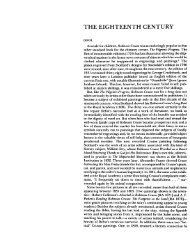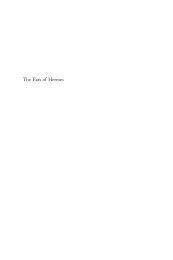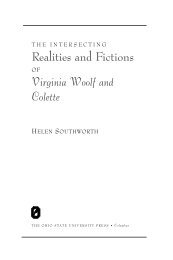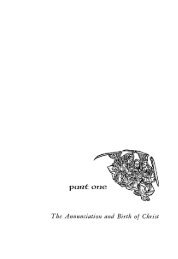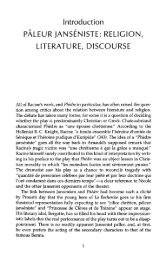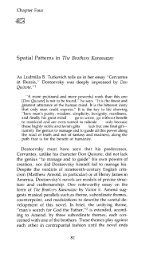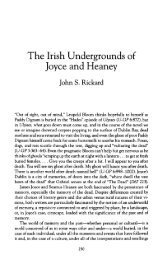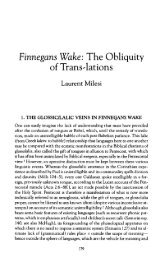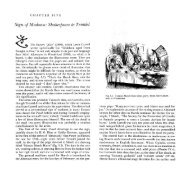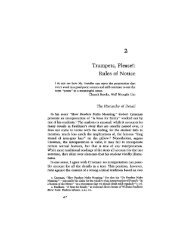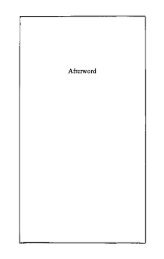Postclassical Narratology: Approaches and Analyses
Postclassical Narratology: Approaches and Analyses
Postclassical Narratology: Approaches and Analyses
Create successful ePaper yourself
Turn your PDF publications into a flip-book with our unique Google optimized e-Paper software.
12 Introduction<br />
worlds) on the basis of their real-world knowledge; cognitive narratology<br />
seeks to describe the range of cognitive processes that are involved. Alan<br />
Palmer (2004) <strong>and</strong> Lisa Zunshine (2006), for instance, argue that the way in<br />
which we attempt to make sense of fictional narratives is similar to the way in<br />
which we try to make sense of other people. They argue that we underst<strong>and</strong><br />
narratives by underst<strong>and</strong>ing the minds of the characters <strong>and</strong> narrators, that<br />
is, their intentions <strong>and</strong> motivations. Most importantly, cognitive approaches<br />
are based on a constructivist theory of reading, arguing that what we read<br />
into texts is not necessarily “there” as a pre-given fact. This emphasis ties in<br />
with non-essentialist, pluralist, <strong>and</strong> generally pragmatic concerns <strong>and</strong> preoccupations,<br />
thereby establishing connections with recent developments in<br />
linguistics, where the direction of research has also moved from syntax to<br />
pragmatics <strong>and</strong> on to cognitive approaches. Cognitive narratology can thus<br />
be argued to affect the status of categories of narratological analysis; it shifts<br />
the emphasis from an essentialist, universal, <strong>and</strong> static underst<strong>and</strong>ing of narratological<br />
concepts to seeing them as fluid, context-determined, prototypical,<br />
<strong>and</strong> recipient-constituted.<br />
Possible-worlds theory is an area of narratological study which links<br />
with postclassical narratology in interesting ways. The basic assumption of<br />
possible-worlds theory is that reality is a universe composed of a plurality<br />
of distinct elements. The actual world (AW) is the central element, <strong>and</strong> it is<br />
surrounded by various alternative possible worlds (APWs), such as dreams,<br />
fantasies, hallucinations, <strong>and</strong> the worlds of literary fiction. For a world to be<br />
possible it must be linked to the center by “accessibility relations.” Important<br />
possible-worlds theorists are Lubomír Doležel (1998), Marie-Laure Ryan<br />
(1991, 1999, 2001, 2005, <strong>and</strong> 2006), <strong>and</strong> Ruth Ronen (1994). It could be<br />
argued that Marie-Laure Ryan’s more recent research (1999, 2001, <strong>and</strong> 2004)<br />
constitutes an interesting postclassical development over Doležel’s <strong>and</strong> her<br />
own earlier work (Ryan 1991). Her forays into media studies highlight the<br />
way in which the underlying cognitivist <strong>and</strong> transmedial aspects of her 1991<br />
model have been extended <strong>and</strong> explicated in the last fifteen years. Furthermore,<br />
Ryan has recently shown that postmodern narratives have found in the<br />
concepts of possible-worlds theory “a productive plaything for [their] games<br />
of subversion <strong>and</strong> self-reflexivity” (2005: 449). She also looks at potential<br />
analogies between parallel universes in physics on the one h<strong>and</strong> <strong>and</strong> possible<br />
worlds in narrative fiction on the other (esp. Ryan 2006). Ryan’s concept of<br />
immersion (Ryan 2001), moreover, builds a bridge to cognitive studies of narration.<br />
We just referred to the pragmatic revolution in linguistics with the development<br />
of context-oriented models in text linguistics, speech act theory,



